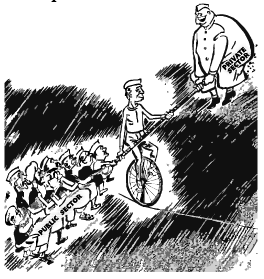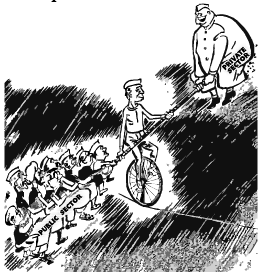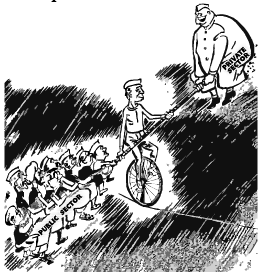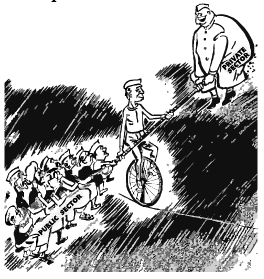Test: Politics of Planned Development- Case Based Type Questions - Humanities/Arts MCQ
16 Questions MCQ Test - Test: Politics of Planned Development- Case Based Type Questions
Study the cartoon given below carefully and answer the questions that follow:

Q. Why has a big tilt towards the public sector been shown in the cartoon?

Study the cartoon given below carefully and answer the questions that follow:

Q. How did the public sector affect the private sector?

Study the cartoon given below carefully and answer the questions that follow:

Q. Who in the picture is balancing between the public and private sectors?

Study the cartoon given below carefully and answer the questions that follow:

Q. Which type of economic model was adopted by India?
Read the following passage carefully and answer the questions that follow:
On the eve of Independence, India had before it, two models of modern development: the liberalcapitalist model as in much of Europe and the US and the socialist model as in the USSR. There were many in India then who were deeply impressed by the Soviet model of development. These included not just the leaders of the Communist Party of India, but also those of the Socialist Party and leaders like Nehru within the Congress. There were very few supporters of the American style capitalist development. As in the USSR, the Planning Commission of India opted for Five Year Plans (FYP). The idea is very simple: The Government of India prepares a document that has a plan for all its income and expenditure for the next five years. Accordingly, the budget of the Central and all the State governments is divided into two parts: ‘non-plan’ budget that is spent on routine items on a yearly basis and ‘plan’ budget that is spent on a five-year basis as per the priorities fixed by the plan. A five-year plan has the advantage of permitting the government to focus on the larger picture and make long-term intervention in the economy. The draft of the First Five Year Plan and then the actual Plan Document, released in December 1951, generated a lot of excitement in the country.
Q. Which model had the least supporters in India?
Read the following passage carefully and answer the questions that follow:
On the eve of Independence, India had before it, two models of modern development: the liberalcapitalist model as in much of Europe and the US and the socialist model as in the USSR. There were many in India then who were deeply impressed by the Soviet model of development. These included not just the leaders of the Communist Party of India, but also those of the Socialist Party and leaders like Nehru within the Congress. There were very few supporters of the American style capitalist development. As in the USSR, the Planning Commission of India opted for Five Year Plans (FYP). The idea is very simple: The Government of India prepares a document that has a plan for all its income and expenditure for the next five years. Accordingly, the budget of the Central and all the State governments is divided into two parts: ‘non-plan’ budget that is spent on routine items on a yearly basis and ‘plan’ budget that is spent on a five-year basis as per the priorities fixed by the plan. A five-year plan has the advantage of permitting the government to focus on the larger picture and make long-term intervention in the economy. The draft of the First Five Year Plan and then the actual Plan Document, released in December 1951, generated a lot of excitement in the country.
Q. When was the draft of first five-year plan was released?
Read the following passage carefully and answer the questions that follow:
On the eve of Independence, India had before it, two models of modern development: the liberalcapitalist model as in much of Europe and the US and the socialist model as in the USSR. There were many in India then who were deeply impressed by the Soviet model of development. These included not just the leaders of the Communist Party of India, but also those of the Socialist Party and leaders like Nehru within the Congress. There were very few supporters of the American style capitalist development. As in the USSR, the Planning Commission of India opted for Five Year Plans (FYP). The idea is very simple: The Government of India prepares a document that has a plan for all its income and expenditure for the next five years. Accordingly, the budget of the Central and all the State governments is divided into two parts: ‘non-plan’ budget that is spent on routine items on a yearly basis and ‘plan’ budget that is spent on a five-year basis as per the priorities fixed by the plan. A five-year plan has the advantage of permitting the government to focus on the larger picture and make long-term intervention in the economy. The draft of the First Five Year Plan and then the actual Plan Document, released in December 1951, generated a lot of excitement in the country.
Q. Which two models of modern development did India follow?
Read the following passage carefully and answer the questions that follow:
On the eve of Independence, India had before it, two models of modern development: the liberalcapitalist model as in much of Europe and the US and the socialist model as in the USSR. There were many in India then who were deeply impressed by the Soviet model of development. These included not just the leaders of the Communist Party of India, but also those of the Socialist Party and leaders like Nehru within the Congress. There were very few supporters of the American style capitalist development. As in the USSR, the Planning Commission of India opted for Five Year Plans (FYP). The idea is very simple: The Government of India prepares a document that has a plan for all its income and expenditure for the next five years. Accordingly, the budget of the Central and all the State governments is divided into two parts: ‘non-plan’ budget that is spent on routine items on a yearly basis and ‘plan’ budget that is spent on a five-year basis as per the priorities fixed by the plan. A five-year plan has the advantage of permitting the government to focus on the larger picture and make long-term intervention in the economy. The draft of the First Five Year Plan and then the actual Plan Document, released in December 1951, generated a lot of excitement in the country.
Q. The Budget is divided into which two parts?
Read the following paragraph and answer the questions that follow:
NITI Aayog or National Institution for Transforming India Aayog is basically a policy think tank of Government of India and State Governments that replaces the 65-year old Planning Commission. Union Government of India had announced formation of NITI Aayog on 1st January, 2015. The body is comprised of a CEO and a Vice Chairperson, to be appointed by the Prime Minister, in addition to some full-time members and two part-time members, while four Union Ministers would serve as ex-officio members. Besides, there would be specific regional councils, while experts and specialists from various fields would be called as special invitees nominated by the Prime Ministers. NITI Aayog will serve as a “think tank” of the government as a “directional and policy dynamo” and would provide both to the governments at the centre and in the states with strategic and technical advice on key policy matters including economic issues of national and international importance. NITI Aayog will have regional councils to focus on developmental activities on specific areas and is patterned on the National Reforms Development Commission of China.
Q. The CEO and Vice Chairperson of NITI Aayog is appointed by .................... .
Read the following paragraph and answer the questions that follow:
NITI Aayog or National Institution for Transforming India Aayog is basically a policy think tank of Government of India and State Governments that replaces 65-year old Planning Commission. Union Government of India had announced formation of NITI Aayog on 1st January, 2015. The body is comprised of a CEO and a Vice Chairperson, to be appointed by the Prime Minister, in addition to some full-time members and two part-time members, while four Union Ministers would serve as ex-officio members. Besides, there would be specific regional councils, while experts and specialists from various fields would be called as special invitees nominated by the Prime Ministers. NITI Aayog will serve as a “think tank” of the government as a “directional and policy dynamo” and would provide both to the governments at the centre and in the states with strategic and technical advice on key policy matters including economic issues of national and international importance. NITI Aayog will have regional councils to focus on developmental activities on specific areas and is patterned on the National Reforms Development Commission of China.
Q. Which councils NITI Aayog will have to focus on developmental activities on specific areas and is patterned on the National Reforms Development Commission of China?
Read the following paragraph and answer the questions that follow:
NITI Aayog or National Institution for Transforming India Aayog is basically a policy think tank of Government of India and State Governments that replaces 65-year old Planning Commission. Union Government of India had announced formation of NITI Aayog on 1st January, 2015. The body is comprised of a CEO and a Vice Chairperson, to be appointed by the Prime Minister, in addition to some full-time members and two part-time members, while four Union Ministers would serve as ex-officio members. Besides, there would be specific regional councils, while experts and specialists from various fields would be called as special invitees nominated by the Prime Ministers. NITI Aayog will serve as a “think tank” of the government as a “directional and policy dynamo” and would provide both to the governments at the centre and in the states with strategic and technical advice on key policy matters including economic issues of national and international importance. NITI Aayog will have regional councils to focus on developmental activities on specific areas and is patterned on the National Reforms Development Commission of China.
Q. When was NITI Aayog formed?
Read the following paragraph and answer the questions that follow:
NITI Aayog or National Institution for Transforming India Aayog is basically a policy think tank of Government of India and State Governments that replaces 65-year old Planning Commission. Union Government of India had announced formation of NITI Aayog on 1st January, 2015. The body is comprised of a CEO and a Vice Chairperson, to be appointed by the Prime Minister, in addition to some full-time members and two part-time members, while four Union Ministers would serve as ex-officio members. Besides, there would be specific regional councils, while experts and specialists from various fields would be called as special invitees nominated by the Prime Ministers. NITI Aayog will serve as a “think tank” of the government as a “directional and policy dynamo” and would provide both to the governments at the centre and in the states with strategic and technical advice on key policy matters including economic issues of national and international importance. NITI Aayog will have regional councils to focus on developmental activities on specific areas and is patterned on the National Reforms Development Commission of China.
Q. How will NITI Aayog serve India?
Read the following passage carefully and answer the questions that follow:
The Second Five Year Plan stressed on heavy industries. It was drafted by a team of economists and planners under the leadership of P.C. Mahalanobis. If the first plan had preached patience, the second wanted to bring about quick structural transformation by making changes simultaneously in all possible directions. Before this plan was finalized, the Congress party at its session held at Avadi near the then Madras city, passed an important resolution. It declared that ‘Socialist pattern of society’ was its goal. This was reflected in the Second Plan. The government imposed substantial tariffs on imports in order to protect domestic industries. Such a protected environment helped both public and private sector industries to grow. As savings and investment were growing in this period, a bulk of these industries like electricity, railways, steel, machineries and communication could be developed in the public sector. Indeed, such a push for industrialisation marked a turning point in India’s development.
Q. What was anticipated from the Second Five Year Plan?
Read the following passage carefully and answer the questions that follow:
The Second Five Year Plan stressed on heavy industries. It was drafted by a team of economists and planners under the leadership of P.C. Mahalanobis. If the first plan had preached patience, the second wanted to bring about quick structural transformation by making changes simultaneously in all possible directions. Before this plan was finalized, the Congress party at its session held at Avadi near the then Madras city, passed an important resolution. It declared that ‘Socialist pattern of society’ was its goal. This was reflected in the Second Plan. The government imposed substantial tariffs on imports in order to protect domestic industries. Such protected environment helped both public and private sector industries to grow. As savings and investment were growing in this period, a bulk of these industries like electricity, railways, steel, machineries and communication could be developed in the public sector. Indeed, such a push for industrialisation marked a turning point in India’s development.
Q. Why did government impose substantial tariffs on imports?
Read the following passage carefully and answer the questions that follow:
The Second Five Year Plan stressed on heavy industries. It was drafted by a team of economists and planners under the leadership of P.C. Mahalanobis. If the first plan had preached patience, the second wanted to bring about quick structural transformation by making changes simultaneously in all possible directions. Before this plan was finalized, the Congress party at its session held at Avadi near the then Madras city, passed an important resolution. It declared that ‘Socialist pattern of society’ was its goal. This was reflected in the Second Plan. The government imposed substantial tariffs on imports in order to protect domestic industries. Such protected environment helped both public and private sector industries to grow. As savings and investment were growing in this period, a bulk of these industries like electricity, railways, steel, machineries and communication could be developed in the public sector. Indeed, such a push for industrialisation marked a turning point in India’s development.
Q. Who drafted the Second Five Year Plan?
Read the following passage carefully and answer the questions that follow:
The Second Five Year Plan stressed on heavy industries. It was drafted by a team of economists and planners under the leadership of P.C. Mahalanobis. If the first plan had preached patience, the second wanted to bring about quick structural transformation by making changes simultaneously in all possible directions. Before this plan was finalized, the Congress party at its session held at Avadi near the then Madras city, passed an important resolution. It declared that ‘Socialist pattern of society’ was its goal. This was reflected in the Second Plan. The government imposed substantial tariffs on imports in order to protect domestic industries. Such protected environment helped both public and private sector industries to grow. As savings and investment were growing in this period, a bulk of these industries like electricity, railways, steel, machineries and communication could be developed in the public sector. Indeed, such a push for industrialisation marked a turning point in India’s development.
Q. What goal was declared by the Congress Party at the session held at Avadi?



















